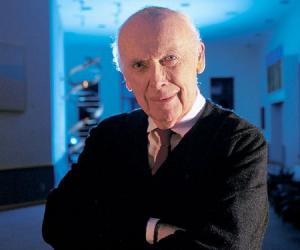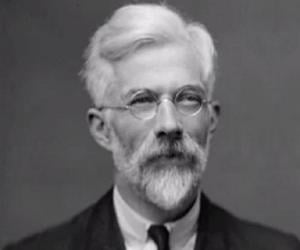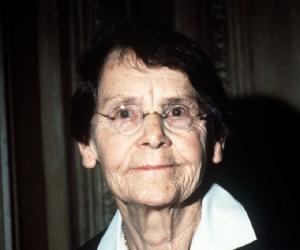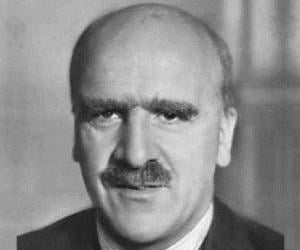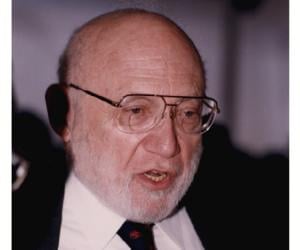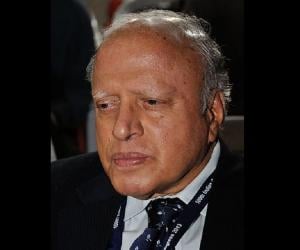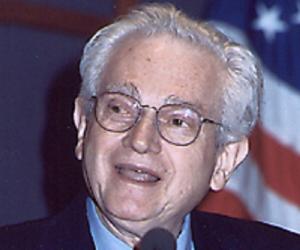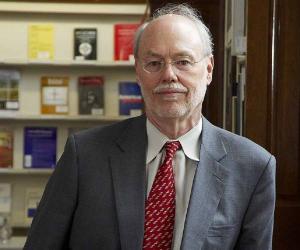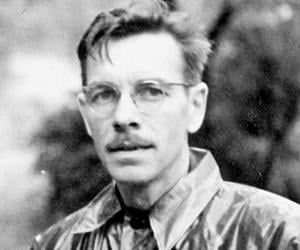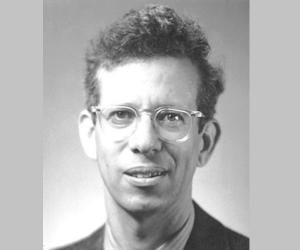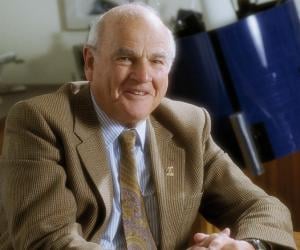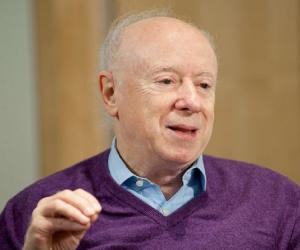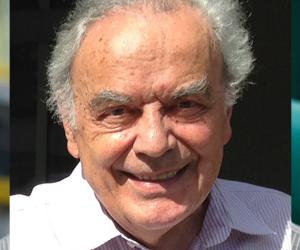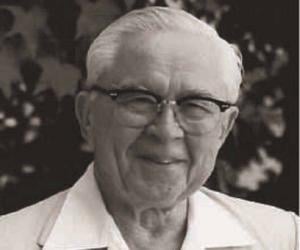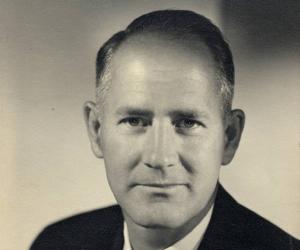James Watson is a geneticist, molecular biologist, and zoologist. He is credited with co-authoring the academic paper that propounded the double helix structure of nucleic acids such as DNA for which he was awarded the Nobel Prize in 1962. In 1977, he was honored with the Presidential Medal of Freedom. In 1997, he was awarded the National Medal of Science.
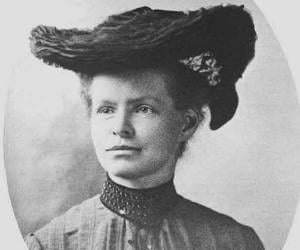
Nettie Stevens was an American geneticist. She is credited with discovering sex chromosomes which later came to be known as the X and Y chromosomes. In 1994, Nettie Stevens was inducted into the National Women's Hall of Fame.
Ronald Fisher was a British polymath, statistician, geneticist, mathematician, and academic. He is credited to have single-handedly created the foundations for modern statistical science. He made important contributions to the field of genetics and is known as one of the three principal founders of population genetics. He was elected to the Royal Society in 1929.
Barbara McClintock was a scientist and cytogeneticist who received the 1983 Nobel Prize in Physiology or Medicine. She earned her Ph.D. in botany from Cornell University and began her lifelong work in the development of maize cytogenetics. She eventually gained recognition as among the best in the field and was honored with several prestigious awards.
British geneticist J.B.S. Haldane is remembered for his pioneering use of statistics in biology. A proponent of neo-Darwinism, he was the son of physiologist John Scott Haldane and had begun assisting his father at age 8. He later joined the British Communist Party and also moved to India.
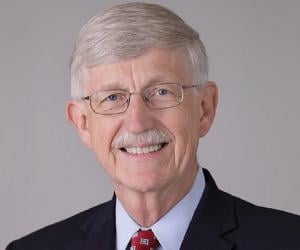
American physician-geneticist Francis Collins is known for his discovery of the genes related with several diseases and for leading the Human Genome Project while serving as director of NHGRI. Recipient of Presidential Medal of Freedom and the National Medal of Science, Collins wrote the New York Times bestseller The Language of God and presently serves as director of the NIH.
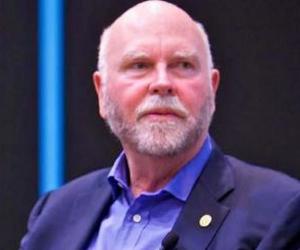
Craig Venter biotechnologist and businessman best known for leading the first draft sequence of the human genome. He is the founder of Celera Genomics and the Institute for Genomic Research (TIGR) and the co-founder of Human Longevity Inc. He received the Dan David Prize for his contribution to genome research and is a member of the American Philosophical Society.

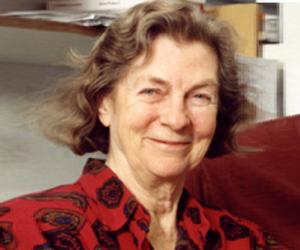
Geneticist Anne McLaren is remembered for her pioneering research in embryology that paved the way for further research in fertility treatments such as in-vitro fertilization. The Royal Society fellow had also appeared as a child actor in the film adaptation of the H.G. Wells novel Things to Come.
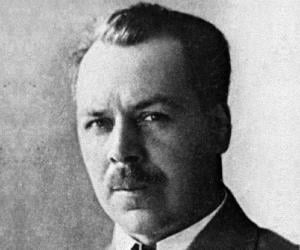
Russian geneticist Nikolai Vavilov not just taught at the University of Saratov but also served as the director of the Bureau of Applied Botany in Petrograd. He made expeditions worldwide, but invited criticism from Soviet agronomist T.D. Lysenko, who was close to Stalin. Vavilov was eventually imprisoned and died in captivity.
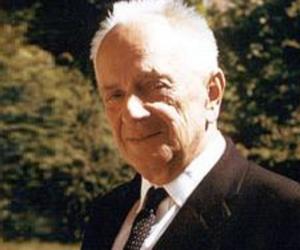
Theodosius Dobzhansky was a Ukrainian-American geneticist and evolutionary biologist. He played a key role in shaping modern synthesis in the field of evolutionary biology. His 1937 book, Genetics and the Origin of Species, is a seminal work on modern synthesis. He was the recipient of several awards, including the US National Medal of Science and the Franklin Medal.
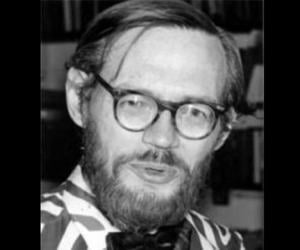
Best known for his theory of Price Equation, American population geneticist, George R. Price, worked as a chemist for more than two decades before shifting to theoretical biology. On reading W.D. Hamilton's paper on kin selection, he eventually started working on it, in the process devising what is today known as Price Equation and also introducing the evolutionarily stable strategy.
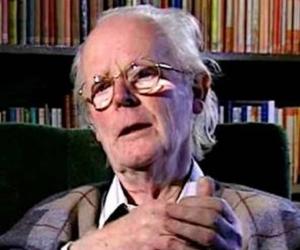
One of the most influential evolutionary biologists of his generation, John Maynard Smith was originally aeronautical engineer. Later, he took a second degree in genetics and did extensive research on subjects like population genetics and evolution of sex. Known for formalizing the central concept in evolutionary game theory, he introduced the evolutionarily stable strategy, impacting a wide variety of studies.
Joshua Lederberg was an American molecular biologist best remembered for his work in the field of artificial intelligence, microbial genetics, and the US space program. In 1958, Lederberg won the Nobel Prize in Physiology or Medicine when he was just 33; he won the prize for discovering bacterial conjugation. In 2006, he was honored with the Presidential Medal of Freedom.
Ramon Magsaysay Award-winning geneticist M. S. Swaminathan is best known for his contribution to the Indian Green Revolution. Featured on Time, he introduced high-yielding varieties of wheat and rice seedlings to Indian farmers. He is also known for his administrative work as part of the Indian civil services.
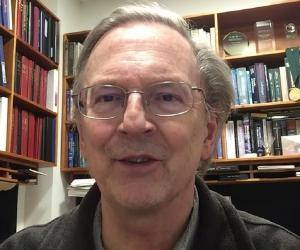
Nobel Prize-winning Canadian-American biochemist and geneticist Jack W. Szostak revolutionized medical science with his research on the manipulation of genes. The Cornell alumnus is credited with creating the first yeast artificial chromosome. He has also taught at the Harvard Medical School. In spite of being Polish, he doesn’t speak the language.
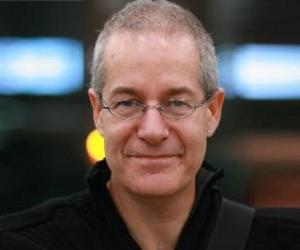
Massimo Pigliucci is an academician currently serving as a professor of philosophy at the City College of New York. A staunch critic of pseudoscience and creationism, he advocates for secularism and science education. He was once the co-host of the Rationally Speaking Podcast. He often writes on topics, such as climate change denial, pseudoscience, intelligent design, and philosophy.
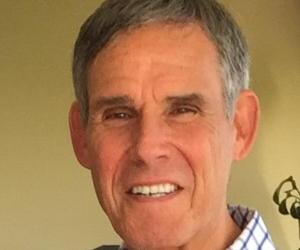
Renowned American cardiologist Eric Topol is the founder-director of the Scripps Research Translational Institute. He is known for his pathbreaking research on genes that can be targeted for the prevention of heart diseases. He was also one of the first to question the safety factor of the medicine Vioxx.
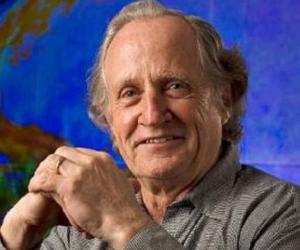
Mario Capecchi is a molecular geneticist who received the 2007 Nobel Prize in Physiology or Medicine along with Oliver Smithies and Martin Evans. They received the prize for discovering a method to create a knockout mouse, a genetically modified mouse in which a certain gene is turned off for experimental purposes. In 2001, Capecchi received the National Medal of Science.
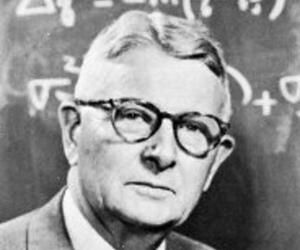
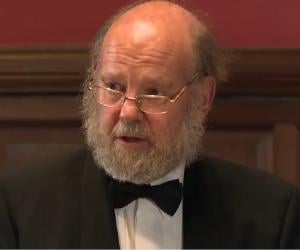
British biologist Ian Wilmut revolutionized embryology by leading the team of researchers who successfully created the first cloned mammal, the sheep named Dolly. A leading proponent of cryopreservation, he also implanted the first calf embryo, Frostie, in a surrogate cow. He was later knighted for his achievements.
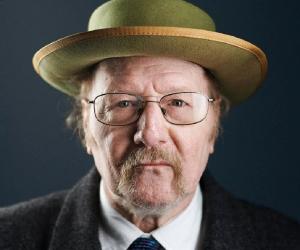
Jeffrey C. Hall is an American chronobiologist and geneticist, currently serving as Brandeis University's Professor Emeritus of Biology. He is credited with conducting extensive research on the behavior and neurology of Drosophila melanogaster (fruit fly), which revealed certain mechanisms of the circadian clocks. He received the 2017 Nobel Prize in Physiology or Medicine along with Michael Rosbash and Michael Young.
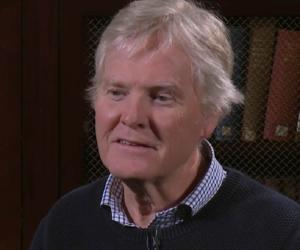
Michael W. Young is a biologist and geneticist. He has spent several years studying genetically controlled patterns of sleep and wakefulness within the fly species Drosophila melanogaster. Along with Jeffrey C. Hall and Michael Rosbash, he was awarded the 2017 Nobel Prize in Physiology or Medicine. His wife, Laurel Eckhardt, is also a biologist and the couple often collaborates professionally.
American biochemist and Nobel laureate Marshall W. Nirenberg is best known for his research on solving the genetic code. The son of a Jewish shirtmaker father, Nirenberg showed an early interest in biology. He led the National Heart Institute’s genetics department and was associated with the National Institutes of Health.
Philip Allen Sharp is an American molecular biologist and geneticist best known for co-discovering RNA splicing. In 1993, he received the prestigious Nobel Prize in Physiology or Medicine along with Sir Richard John Roberts. Philip Allen Sharp has also won several other awards, such as the National Medal of Science, the Benjamin Franklin Medal, and the Louisa Gross Horwitz Prize.
Nobel Prize-winning biologist Alfred Day Hershey is best remembered for his research on bacteriophages, or viruses that infect bacteria. He was associated with the Washington University throughout most of his life. He is also known for his blender experiment, which he conducted with his work partner Martha Chase.
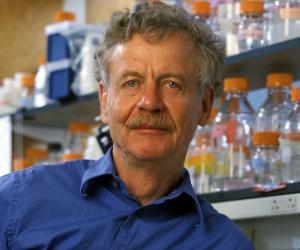
Rudolf Jaenisch is a German Professor of Biology currently working at the Massachusetts Institute of Technology, USA. He is also one of the founding members of the prestigious Whitehead Institute for Biomedical Research, which aims at improving human health through biomedical research. A pioneer of transgenic science, Jaenisch has been creating genetically engineered mice to study neurological diseases and cancer.
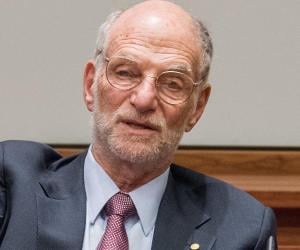
Michael Rosbash is an American chronobiologist and geneticist, currently serving as a researcher and professor at Brandeis University. In 2017, he received the Nobel Prize in Physiology or Medicine along with Jeffrey C. Hall and Michael W. Young for their discoveries of the controlling mechanisms of the circadian cycle. Rosbash has also received many other awards like the Massry Prize.
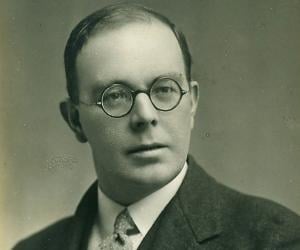
Cyril Burt was an English geneticist and educational psychologist who also made immense contributions to statistics. A prolific writer, Cyril Burt published several books and articles on topics ranging from psychometrics to parapsychology over the course of his career.
Virologist Howard Martin Temin won his Nobel Prize for co-discovering the enzyme reverse transcriptase. His initial research was in the area of animal cancers, as he was also a PhD in animal virology from Caltech. He spent almost his entire academic career teaching at the University of Wisconsin-Madison.

Reginald Punnett was a British geneticist who is credited with creating the Punnett square, which is used by biologists even today to evaluate the probability of genotypes of offspring. He is also credited with co-founding the Journal of Genetics alongside William Bateson in 1910. Reginald Punnett’s book Mendelism is considered by some to be the first textbook on genetics.
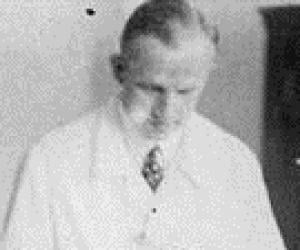
German biologist and eugenicist Otmar Freiherr von Verschuer was an advocate of racial hygiene and the mandatory sterilization of the physically and mentally disabled. He also led the Nazi experiments on twins based on body parts made available to him from the inmates of various concentration camps.
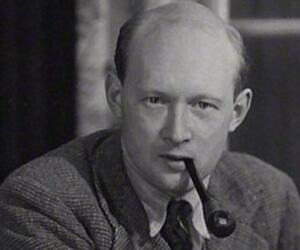
British embryologist C.H. Waddington had studied paleontology before turning to biology. A professor of zoology and embryology, he later also taught animal genetics. His interests also included poetry, painting, and Marxism. He introduced concepts such as epigenetic landscape and genetic assimilation, and penned books such as Principles of Embryology.

Nobel Prize-winning physician Baruch Samuel Blumberg is best remembered for his research on the antigen-antibody reaction. His study of an antibody response against hepatitis B helped later scientists develop a vaccine for the disease. He died soon after delivering a speech at the NASA Ames Research Center.
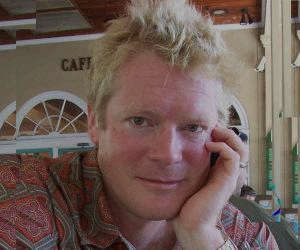
Renowned population geneticist Spencer Wells is best known for his study of human diversity. His analysis has led him to believe that all humans have descended from a single man from Africa, the Y-chromosomal Adam, who lived around 60,000-90,000 years back. He has also headed National Geographic’s Genographic Project.
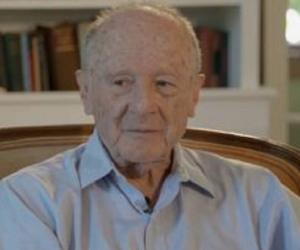
Molecular biologist and geneticist Matthew Meselson is best known for his research on the Watson-Crick theory and the replication of DNA. The Harvard professor has received accolades such as the Guggenheim Fellowship and honorary degrees from eight universities, including Princeton and Yale. He has also been a CIA consultant.
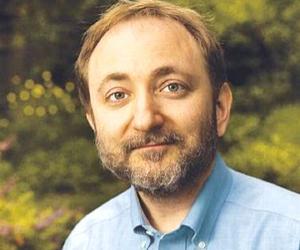
Geneticist Andrew Fire is best known for his Nobel Prize-winning work on the double-stranded RNA. The MIT alumnus did most of his research under the guidance of Nobel laureate Philip A. Sharp. His discovery of the RNAi later aided scientists work on the cure for ailments such as AIDS and cancer.
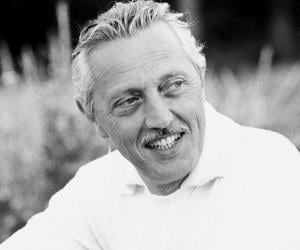
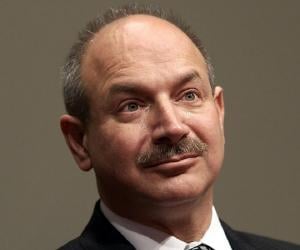
Immunologist Bruce Beutler is best known for his Nobel Prize-winning research on the innate immune system of the human body. The son of a scientist and physician, he was a child prodigy and graduated at age 18. He grew up to be associated with institutes such as the Scripps Research Institute.
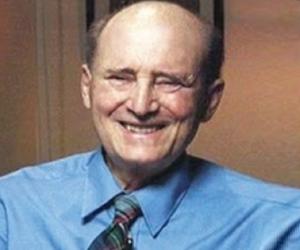
Born to Polish Jew parents in the Bronx, Seymour Benzer would often cut open frogs in childhood. The molecular biologist is best known for his research on viral genes and for coining the term cistron. A Caltech professor, he was also made a Fellow of the Royal Society.
American molecular geneticist Joseph L. Goldstein was born to clothing store owner parents in South Carolina. He ended up winning a Nobel Prize for his research on cholesterol metabolism, which later helped researchers develop statin drugs. He currently chairs the molecular genetics department of the University of Texas.
Werner Arber is a Swiss geneticist and microbiologist whose discovery of restriction endonucleases earned him the prestigious Nobel Prize in Physiology or Medicine in 1978; he shared the award with Daniel Nathans and Hamilton Smith. Arber's work alongside Nathans and Smith led to the progression of recombinant DNA technology. Werner Arber is also credited with co-founding the World Cultural Council.
Edward B. Lewis was an American geneticist who helped found evolutionary developmental biology, a field that compares the developmental processes of various organisms. In 1995, he shared the Nobel Prize in Physiology or Medicine with Eric Wieschaus and Christine Nüsslein-Volhard. He also won several other prestigious awards like the National Medal of Science and the Louisa Gross Horwitz Prize.
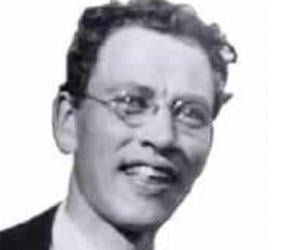
Alfred Sturtevant was an American geneticist. He is credited with constructing a chromosome's first genetic map in 1911. Throughout his career, Sturtevant did extensive research on Drosophila melanogaster (fruit fly) and his research on the Drosophila genome allowed other geneticists to map chromosomes of higher organisms like human beings. Alfred Sturtevant received the prestigious National Medal of Science in 1967.
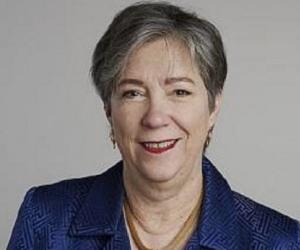
Cell biologist and MIT professor Susan Lindquist is best remembered for her research on protein folding and its impact on diseases. The Harvard alumna had also taught at the University of Chicago for 23 years. She was also the first female director of the Whitehead Institute for Biomedical Research.
George Wells Beadle was an American geneticist who served as the president of the University of Chicago from 1961 until his retirement. In 1958, he received the Nobel Prize in Physiology or Medicine for discovering the role played by genes in controlling the biochemical events within cells. George Wells Beadle also won other awards like the Thomas Hunt Morgan Medal.

Mathilde Krim was an Israeli medical researcher best known for her association with amfAR, an international nonprofit organization that aims at supporting AIDS research; she was the founding chairman of the organization. For her immense contribution to the field of AIDS research, Mathilde Krim was honored with the prestigious Presidential Medal of Freedom in 2000.
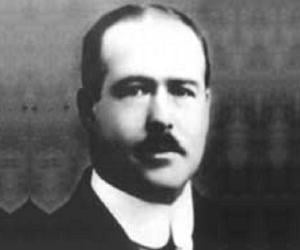
Walter Sutton was an American physician and geneticist best remembered for his Boveri-Sutton chromosome theory, which is widely regarded as one of the most important contributions to present-day biology. Walter Sutton is also credited with improving several medical and surgical practices, such as anesthetic techniques.
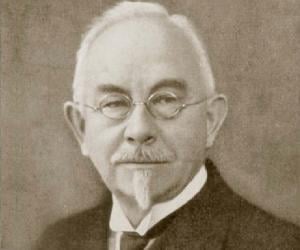
Danish geneticist and botanist Wilhelm Ludvig Johannsen is remembered for his research on plant heredity. Initially a professor, who had also taught plant physiology at the University of Copenhagen, he later focused on research. He is also credited with coining the terms phenotype, genotype, and genes.
